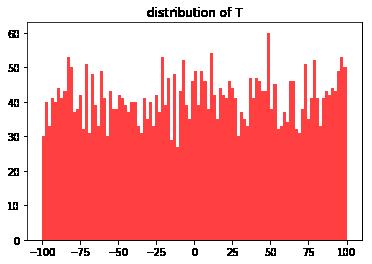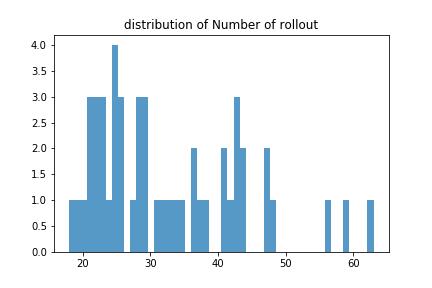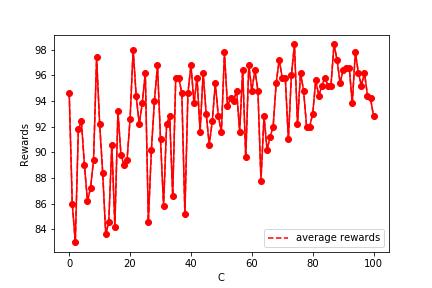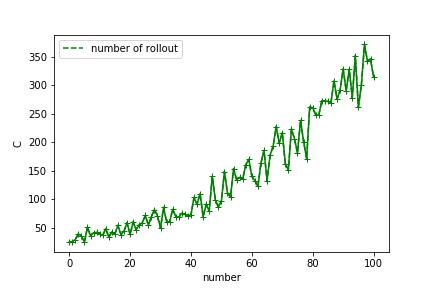蒙特卡洛树搜索(MonteCarlo Tree Search)
Posted 拉风小宇
tags:
篇首语:本文由小常识网(cha138.com)小编为大家整理,主要介绍了蒙特卡洛树搜索(MonteCarlo Tree Search)相关的知识,希望对你有一定的参考价值。
问题描述
这个题目来自一个我的作业:
Construct a binary tree (each node has two child nodes) of depth
d
=
12
d = 12
d=12 and assign different values to each of the
2
d
2^d
2d leaf-nodes. Implement the MCTS algorithm and apply it to the above tree to search for the optimal value.
我们看看能不能通过MCTS找到最大的叶子节点。
定义类和函数
我们需要定义类和函数,用来实现这个作业
节点类
在节点类中,有节点编号key,节点左右儿子left,right,父节点p,遍历次数n和回报和t。
此外还有两个方法判断其是否是叶子结点(没有子结点),以及计算该节点的UCB(Upper Confidence Bound)值,其实UCB在某种程度上就是在鼓励你多去走走还没走过的路,避免过早收敛
import math
# Python implementation to construct a Binary Tree from
# parent array
# A node structure
class Node:
# A utility function to create a new node
def __init__(self, key, t, n):
self.key = key
self.left = None
self.right = None
self.t = t
self.n = n
self.p = None
def get_parent(self, p):
self.p = p
def judge_leave_nodes(self):
if (self.left == None) and (self.right == None):
return True
else:
return False
def calculate_UCB(self):
C = 0.2
if (self.n == 0):
if self.judge_leave_nodes():
UCB = self.t + 1000
else:
UCB = 1000
else:
UCB = self.t/self.n + C * math.sqrt(math.log(self.p.n)/self.n)
return UCB
创建节点和树的函数
定义函数来创建树
def createNode(parent, T,N, i, created, root):
# If this node is already created
if created[i] is not None:
return
# Create a new node and set created[i]
created[i] = Node(i,T[i],N[i])
# If 'i' is root, change root pointer and return
if parent[i] == -1:
root[0] = created[i] # root[0] denotes root of the tree
return
# If parent is not created, then create parent first
if created[parent[i]] is None:
createNode(parent, parent[i], T[i],N[i], created, root )
# Find parent pointer
p = created[parent[i]]
created[i].get_parent(p)
# If this is first child of parent
if p.left is None:
p.left = created[i]
# If second child
else:
p.right = created[i]
# Creates tree from parent[0..n-1] and returns root of the
# created tree
def createTree(parent):
n = len(parent)
# Create and array created[] to keep track
# of created nodes, initialize all entries as None
created = [None for i in range(n+1)]
root = [None]
for i in range(n):
createNode(parent, T, N, i, created, root)
return root[0]
中序遍历树
用来中序遍历树,就是显示一下啦🙂
#Inorder traversal of tree
def inorder(root):
if root is not None:
inorder(root.left)
print (root.key, root.t, root.n, root.p)
inorder(root.right)
MCTS函数
内含MCTS的四个步骤,即Selection、Expansion、Simulation和Backpropagation
def MCTS(root):
node = root
Rollout_node = None
Previous_Rollout_node = root
number_of_rollout = 0
# choose the same path
while (Rollout_node is not Previous_Rollout_node):
# until reach leaf node
while (node.judge_leave_nodes() is not True):
left = node.left
right = node.right
## Selection
UCB_left = left.calculate_UCB()
UCB_right = right.calculate_UCB()
if (UCB_left >= UCB_right):
node = left
else:
node = right
# the node is the leaf node now, a rollout complete
# backpropagation
Previous_Rollout_node = Rollout_node
Rollout_node = node
number_of_rollout += 1
#print ("Inorder Traversal of constructed tree")
#print(inorder(root))
while node.p is not None:
node.p.t += Rollout_node.t
node.p.n += 1
node = node.p
node = Rollout_node
#print("The best path:")
#while node.p is not None:
# print("%d<-" %(node.key), end='')
# node = node.p
#print(root.key)
#print("The Reward: %d" %(Rollout_node.t))
print("The Number of Rollout: %d" %(number_of_rollout))
return Rollout_node.t
我这里设置的结束条件是两次走同一条路,也就意味着别的路没有可能再试了,我感觉还是很makesense的。
测试效果
初始化一颗树
我们这里先做一颗简单的树,除了T的最后 2 d e p t h 2^depth 2depth个数是我们制定的,其他的数都是和depth相关的,有规律的。
# 0:0 0
# / \\
# 1:0 0 2: 0 0
# / \\ / \\
#3:2 0 4:1 0 5:-1 0 6:3 0
parent = [-1, 0, 0, 1, 1, 2, 2]
T = [0, 0, 0, 2, 1, -1, 3]
N = [0,0,0,0,0,0,0]
root = createTree(parent)
print ("Inorder Traversal of constructed tree")
inorder(root)
MCTS(root)
通过3步,最终找到的是 0 → 1 → 3 0\\rightarrow1\\rightarrow3 0→1→3这条路,得到的数是2
MCTS有问题?
我感觉MCTS的问题在上面的例子里还是看得出来,开始的时候都没有走过,会向左到1,然后向左到3,没毛病。第二次右边没走过到2,然后都没有走过向左到5。那么问题来了,2的值已经被5拉低了,也就是现在由于5的表现差拖累了2,进一步让6(原本是最好的)根本没有机会被遍历。这就是MCTS的问题。
不过这是因为5和6的数差的太多,实际上我感觉并不会,比如下围棋,我猜想你上一步走的很差,下一步大概率怎么走都不太行?(也说不准)
但是还是这个意思,MCTS的兄弟节点某种程度上在相互影响,甚至拖累。
不过既然没有所有都遍历,就得承担这个风险😏,你不能啥都要吧┓( ´∀` )┏
回归问题
现在我们设置 d e p t h = 12 depth=12 depth=12也就是一共四千多个节点,先初始化数
import numpy as np
depth = 12
N = [0]*((2**(depth+1) -1))
T = [0]*((2**(depth) -1))
T.extend(np.random.randint(-100,101,2**(depth)).tolist())
import matplotlib.pyplot as plt
plt.hist(T[(2**(depth) -1):],bins = 100,color='red',histtype='stepfilled',alpha=0.75)
plt.title('distribution of T')
plt.show()
parent = [-1]
for i in range((2**depth) -1):
parent.append(i)
parent.append(i)
root = createTree(parent)
#print ("Inorder Traversal of constructed tree")
#inorder(root)
MCTS(root)
最后一层有四千多个数,我们从-100到100都有,所以理论上应该最优解是100.
我们做50次这个实验,看看得到的数都是多少(rewards)以及用多少步得到这个数(number_of_rollout)
import numpy as np
depth = 12
rewards = []
numbers_of_rollout = []
for i in range(50):
N = [0]*((2**(depth+1) -1))
T = [0]*((2**(depth) -1))
T.extend(np.random.randint(-100,101,2**(depth)).tolist())
import matplotlib.pyplot as plt
parent = [-1]
for i in range((2**depth) -1):
parent.append(i)
parent.append(i)
root = createTree(parent)
[R,N] = MCTS(root)
rewards.append(R)
numbers_of_rollout.append(N)
所有的子结点我们分配的数值为

所以确实应该可以得到100,但是也有-100,平均值是-1.07。那我们看看MCTS的表现吧~
看看效果吧
我们画一下这两个的分布

平均可以得到88.58,感觉还是可以的,除了那个五十几不太行,我猜他是被兄弟拖累了hhh?

这个数我觉得更有用,平均32.56步就可以得到一个相对好的值,这太不容易了,把所有的遍历一遍要
2
12
2^12
212步,省了也太多了吧,这么看起来88.58还是不错的✌️
C的作用
在UCB中C是用来平衡exploration和exploitation的。越大的C会让rollout的时候更加倾向于走那些没怎么走过的点,也就是走过的路应该会变得更多,得到的结果就应该会变得更好,让我们看一下实际效果吧~~

可以看出来确实是变好了一点,不太显著不过也可以理解,毕竟已经这么好了~~

也可以看得出来明显rollout个数是在上升的~
C确实是在做一个平衡(tradeoff),到底是选择更好的reward还是更少的rollout,由你选择咯(practically choice)。
不过我看wiki说一般选择
(
2
)
\\sqrt(2)
(2)我也不知道为什么我这里的C仿佛应该取的很大的样子。。不管了问题不大
最后把最后一段的代码附上,还有个小tip,我发现np.log,np.sqrt比math.*好用哈哈哈
Rewards = []
Number_Of_Rolls = []
def frange(start, stop=None, step=None):
if stop == None:
stop = start + 0.0
start = 0.0
if step == None:
step = 1.0
while True:
if step > 0 and start >= stop:
break
elif step < 0 and start <= stop:
break
yield ("%g" % start) # return float number
start = start + step
import numpy as np
# Python implementation to construct a Binary Tree from
# parent array
C = 0.0
while C <= 100:
# A node structure
class Node:
# A utility function to create a new node
def __init__(self, key, t, n):
self.key = key
self.left = None
self.right = None
self.t = t
self.n = n
self.p = None
def get_parent(self, p):
self.p = p
def judge_leave_nodes(self):
if (self.left == None) and (self.right == None):
return True
else:
return False
def calculate_UCB(self):
#C = 0.2
if (self.n == 0):
if self.judge_leave_nodes():
UCB = self.t + 1000
else:
UCB = 1000
else:
UCB = self.t/self.n + C * np.sqrt(np.log(self.p.n)/self.n)
return UCB
def createNode(parent, T,N, i, created, root):
# If this node is already created
if created[i] is not None:
return
# Create a new node and set created[i]
created[i] = Node(i,T[i],N[i])
# If 'i' is root, change root pointer and return
if parent[i] == -1:
root[0] = created[i] # root[0] denotes root of the tree
return
# If parent is not created, then create parent first
if created[parent[i]] is None:
createNode(parent, parent[i], T[i],N[i], created, root )
# Find parent pointer
p = created[parent[i]]
created[i].get_parent(p)
# If this is first child of parent
if p.left is None:
p.left = created[i]
# If second child
else:
p.right = created[i]
# Creates tree from parent[0..n-1] and returns root of the
# created tree
def createTree(parent):
n = len(parent)
# Create and array created[] to keep track
# of created nodes, initialize all entries as None
created = [None for i in range(n+1)]
root = [None]
for i in range(n):
createNode(parent, T, N, i, created, root)
return root[0]
#Inorder traversal of tree
def inorder(root):
if root is not None:
inorder(root.left)
print (root.key, root.t, root.n, root.p)
inorder(root.right)
def MCTS(root):
node = root
Rollout_node = None
Previous_Rollout_node = root
number_of_rollout = 0
# choose the same path
while (Rollout_node is not Previous_Rollout_node):
# until reach leaf node
while (node.judge_leave_nodes() is not True):
left = node.left
right = node.right
## Selection
UCB_left = left.calculate_UCB()
UCB_right = right.calculate_UCB()
if (UCB_left >= UCB_right):
node = left
else:
node = right
# the node is the leaf node now, a rollout complete
# backpropagation
Previous_Rollout_node = Rollout_node
Rollout_node = node
number_of_rollout += 1
#print ("Inorder Traversal of constructed tree")
#print(inorder(root))
while node.p is not None:
node.p.t += Rollout_node.t
node.p.n += 1
node = node.p
node = Rollout_node
#print("The best path:")
#while node.p is not None:
# print("%d<-" %(node.key), end='')
# node = node.p
#print(root.key)
#print("The Reward: %d" %(Rollout_node.t))
#print("The Number of Rollout: %d" %(number_of_rollout))
return (Rollout_node.t,number_of_rollout)
import numpy as np
depth = 12
rewards = []
numbers_of_rollout = []
for i in range(5):
N = [0]*((2**(depth